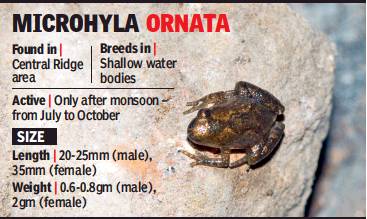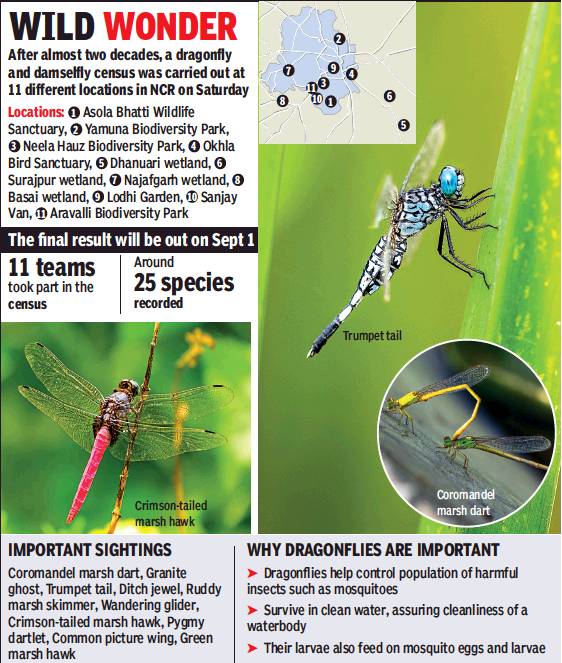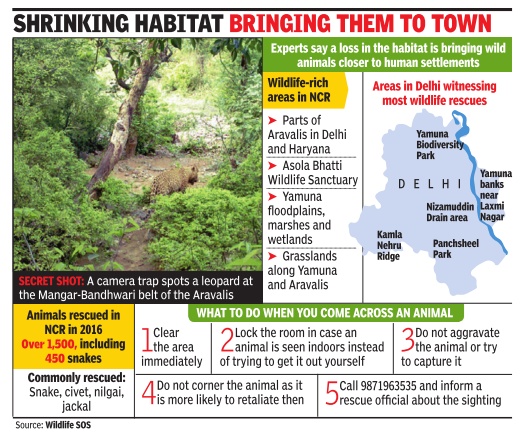Delhi: Wildlife (Fauna)
(→Leopards) |
(→Insects) |
||
| Line 80: | Line 80: | ||
Among the important sightings at YBP included Blue darner, Pied paddy skimmer, Common picture wing, Granite ghost, Coromandel marsh dart, Orange-tailed marsh dart, and Pixie dartlet by a team led by entomologist Mohammad Faisal. Other locations like Neela Hauz and Tilpath Valley recorded 9 and 5 species respectively. | Among the important sightings at YBP included Blue darner, Pied paddy skimmer, Common picture wing, Granite ghost, Coromandel marsh dart, Orange-tailed marsh dart, and Pixie dartlet by a team led by entomologist Mohammad Faisal. Other locations like Neela Hauz and Tilpath Valley recorded 9 and 5 species respectively. | ||
| + | |||
| + | = Jackals= | ||
| + | ==‘Human indulgence in forest affecting golden jackal habitat’/ 2019== | ||
| + | [https://epaper.timesgroup.com/Olive/ODN/TimesOfIndia/shared/ShowArticle.aspx?doc=TOIDEL%2F2019%2F04%2F17&entity=Ar00707&sk=72096714&mode=text Mohammad Ibrar, AUD study finds human indulgence in forest affecting golden jackal habitat, April 17, 2019: ''The Times of India''] | ||
| + | |||
| + | [[File: The dwindling number of jackals in Delhi- 2019.jpg|The dwindling number of jackals in Delhi/ 2019 <br/> From: [https://epaper.timesgroup.com/Olive/ODN/TimesOfIndia/shared/ShowArticle.aspx?doc=TOIDEL%2F2019%2F04%2F17&entity=Ar00707&sk=72096714&mode=text Mohammad Ibrar, AUD study finds human indulgence in forest affecting golden jackal habitat, April 17, 2019: ''The Times of India'']|frame|500px]] | ||
| + | |||
| + | |||
| + | The flora and fauna of the forests in the city seem to have been affected by human intervention and interaction. Sanjay Van is home to a large number of golden jackals, which are getting affected by fragmentation and habitat loss. Student researchers at Ambedkar University Delhi found out that these bipeds have started to consume food thrown by joggers or people who come from picnic. The researchers also found that the animals are also prone to attacks from feral dogs in the area. | ||
| + | |||
| + | Sanjay Van, spread over an area of about 3.17 sq kilometres, is surrounded by human establishments on all sides. Ajay Immanuel Gonji, research student at the Centre for Urban Ecology and Sustainability (CUES), has been conducting “methodical research” in the Sanjay Van area. | ||
| + | |||
| + | Using a combination of patch occupancy and camera trapping, an attempt has been made to understand the distribution and habitat use of the golden jackal in the area. | ||
| + | |||
| + | Speaking to TOI, Gonji said that within the forest area, they found a network of jogging tracks and walking trails used for recreational purposes, as well as a couple of religious establishments within the forest that are frequented by people. | ||
| + | |||
| + | This, he said, is likely affecting the habits of the jackals and their herd behaviour. “We couldn't count the animals but studied the change in the forest and the impact on the animals using motion sensing camera trapping,” he said. | ||
| + | |||
| + | The CUES study also inferred that many of these animals leave their locations in the forest to search for food in the periphery region where there are a number of dhabas. | ||
| + | |||
| + | The study is also looking at the conflict between the jackals and feral dogs that often come in contact with each other. “Jackals are under threat from the dog packs as they both have become dependent on human resources.” | ||
| + | |||
| + | CUES, in its inference, also postulated that there is a possibility that the jackals may be forced to reduce their pack size as the space is limited. “Hence, we are seeing a number of road kills because of space issues,” the study said. | ||
| + | |||
| + | “For the common man living in Delhi, it is fascinating to know that there exists such a rich diversity of animals in the city,” Gonji said, adding that there is a need to educate and inform the public. | ||
= Leopards= | = Leopards= | ||
Revision as of 07:57, 18 April 2019
This is a collection of articles archived for the excellence of their content. |
Contents |
Animal species in Delhi, including urban areas
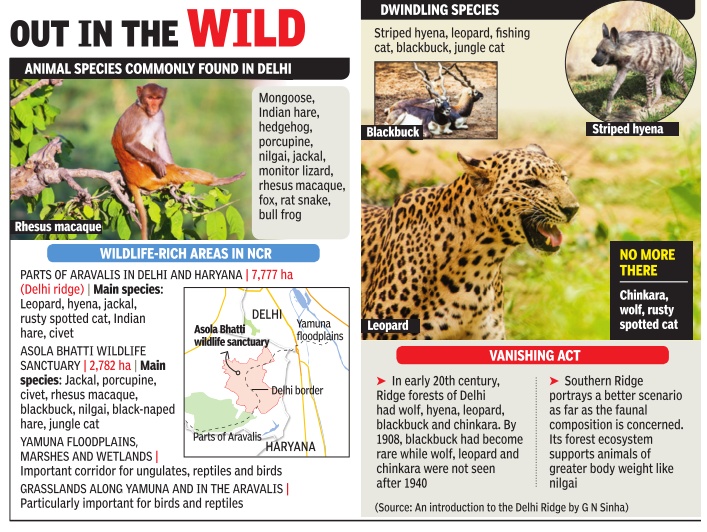
See graphic:
Wildlife, fauna in Delhi, some facts
Biodiversity parks in Delhi
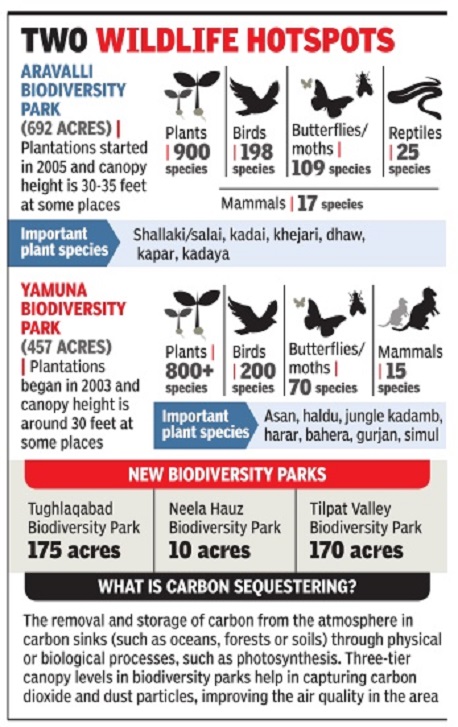
The Times of India
See graphic 'Existing and proposed Biodiversity parks in Delhi'
and also
Asola Bhatti Wildlife Sanctuary (Delhi/ Haryana)
Delhi: Yamuna Biodiversity Park
Frogs
Frog species has no eyes because of pollution
The high pollution in Delhi is proving a threat to the capital’s smallest known vertebrate. The new generation of Microhyla ornata — a small yellowish brown frog — is showing physical deformities at birth such as the absence of eyes. These were established by research conducted by the environment science department of Delhi University’s Sri Venkateswara College.
According to Robin Suyesh, professor of environmental science in the college, the research aimed at studying the behaviour of these amphibians in the Central Ridge area, which is the species’ natural habitat in Delhi. “In the course of our research, however, we found many individuals with missing eyes,” said Suyesh.
The researchers determined that the frogs were suffering from “anophthalmia”, or the absence of the left eye. “Scientific studies across the world have shown pollution, parasitic infection and ultraviolet radiation as the probable reasons for the developmental abnormality among amphibians,” Suyesh pointed out. “Delhi, which happens to be one of the most polluted cities in the world, has seen the quality of habitat constantly degrading due to anthropogenic activities, which might be affecting its biodiversity.”
The population of this species has gone down over the years due to loss of habitat. “Since they are small in size and are seen in the open for only a few months in a year, not many know that this amphibian even exists,” the professor said.
Suyesh revealed that amphibians are currently the most threatened group of vertebrates with more than one-third of the total known species facing extinction. “The amphibians are particularly sensitive to environmental changes and are hence considered to be barometers of environmental change because they are the first to react to any changes around them,” Suyesh said.
Earlier research conducted in the Western Ghats has shown a high number of frogs with deformities. “This alarmed scientists and environmentalists who found that such physical changes were caused by toxicity in the frog’s environment and food chain.” While the frog’s Ridge habitat is “relatively less polluted”, there is nevertheless a need to reduce pollution levels in Delhi to stop it from facing extinction.
Insects
Dragonfly, damselfly
Jasjeev Gandhiok, August 2, 2018: The Times of India
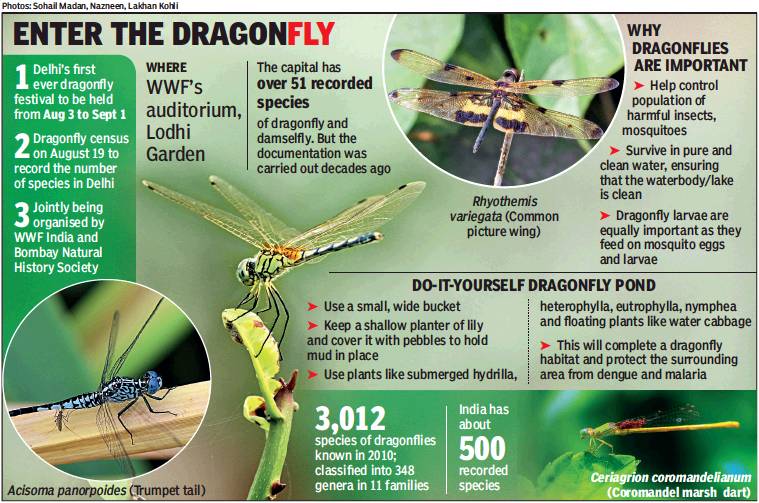
From: Jasjeev Gandhiok, August 2, 2018: The Times of India
Experts said dragonflies and damselflies — similar to dragonflies and belonging to the same family — play a key role in maintaining a healthy ecosystem and are crucial in controlling mosquito population. In the past, Delhi had recorded 51 dragonfly and damselfly species. “However, the documentation is quite old and was done decades ago. We plan to collect fresh data on dragonfly and damselfly species in the city, just like the butterfly census of last year,” says Sohail Madan, centre-manager at BNHS in Asola.
“Dragonflies and damselflies have been an integral part of urban biodiversity for a long time and till their habitat was safe and their numbers sufficient, they kept the population of disease carrying mosquitoes to a minimum. With drastic changes in our city the deadly cases of Dengue and malaria are on the rise,” Madan added.
India has about 500 different types of species at present, while around 3012 species were recorded worldwide until 2010. Experts say the best spots to observe dragonflies are either wetland habitats or forested areas during the monsoons.
“They prefer living close to waterbodies, as the creature lay eggs on water. In NCR, they are easily sighted in large numbers at Okhla bird sanctuary and Asola Bhatti wildlife sanctuary,” said Madan.
“We will also give people a guidebook at the festival on how to identify different species and they can then take part in the census with us,” the BNHS manager added.
2018: reduced numbers
With a camera in one hand and a guidebook in the other, entomologists in NCR set out on Saturday morning to take part in the first dragonfly and damselfly census in the region in almost two decades. The census was part of the dragonfly festival organised by WWF India and Bombay Natural History Society (BNHS), which had kicked off on August 3 and saw over 25 different species recorded, the final results of which will be out on September 1.
The census started as early as 8am in some places, with 11 teams in different parts of NCR with an ‘expert’ member in each team. With around 30 participants, an average of 6 to 8 species were recorded in 11 different areas.
The capital saw such a census last in 1996 by the Zoological Survey of India, when 49 different species were recorded from Delhi. The count this year is likely to be much less, which experts feel may be due to habitat destruction. “We’ve recorded around 25 different species. Due to wetland destruction and more constructions taking place where wetlands used to be, these numbers have come down considerably,” said Sohail Madan, a team leaders and centre manager at BNHS, Asola.
India has around 500 different species of dragonfly and damselflies, both members of the odonata order — a primate group of insects that appeared in the carboniferous age about 220 million years ago. They are aquatic insects and their life history is dependent on freshwater bodies, like rivers and ponds, with female dragonflies laying their eggs in or near water, quite often on floating or emergent plants.
Experts said their presence in the ecosystem is extremely important as they ensure mosquito numbers are controlled. “Most of the dragonfly’s life is spent in the larval stage beneath the surface of water, and they feed on all types of mosquito larvae. The adults also prey on mosquitoes that helps protecting us from vector-borne diseases like malaria or dengue,” said Faiyaz Khudsar, scientist-in-charge at the Yamuna Biodiversity Park(YBP).
Among the important sightings at YBP included Blue darner, Pied paddy skimmer, Common picture wing, Granite ghost, Coromandel marsh dart, Orange-tailed marsh dart, and Pixie dartlet by a team led by entomologist Mohammad Faisal. Other locations like Neela Hauz and Tilpath Valley recorded 9 and 5 species respectively.
Jackals
‘Human indulgence in forest affecting golden jackal habitat’/ 2019
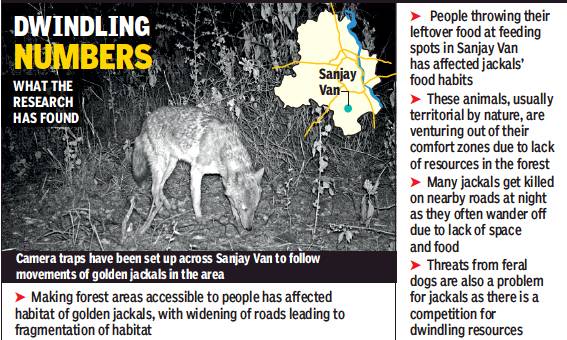
From: Mohammad Ibrar, AUD study finds human indulgence in forest affecting golden jackal habitat, April 17, 2019: The Times of India
The flora and fauna of the forests in the city seem to have been affected by human intervention and interaction. Sanjay Van is home to a large number of golden jackals, which are getting affected by fragmentation and habitat loss. Student researchers at Ambedkar University Delhi found out that these bipeds have started to consume food thrown by joggers or people who come from picnic. The researchers also found that the animals are also prone to attacks from feral dogs in the area.
Sanjay Van, spread over an area of about 3.17 sq kilometres, is surrounded by human establishments on all sides. Ajay Immanuel Gonji, research student at the Centre for Urban Ecology and Sustainability (CUES), has been conducting “methodical research” in the Sanjay Van area.
Using a combination of patch occupancy and camera trapping, an attempt has been made to understand the distribution and habitat use of the golden jackal in the area.
Speaking to TOI, Gonji said that within the forest area, they found a network of jogging tracks and walking trails used for recreational purposes, as well as a couple of religious establishments within the forest that are frequented by people.
This, he said, is likely affecting the habits of the jackals and their herd behaviour. “We couldn't count the animals but studied the change in the forest and the impact on the animals using motion sensing camera trapping,” he said.
The CUES study also inferred that many of these animals leave their locations in the forest to search for food in the periphery region where there are a number of dhabas.
The study is also looking at the conflict between the jackals and feral dogs that often come in contact with each other. “Jackals are under threat from the dog packs as they both have become dependent on human resources.”
CUES, in its inference, also postulated that there is a possibility that the jackals may be forced to reduce their pack size as the space is limited. “Hence, we are seeing a number of road kills because of space issues,” the study said.
“For the common man living in Delhi, it is fascinating to know that there exists such a rich diversity of animals in the city,” Gonji said, adding that there is a need to educate and inform the public.
Leopards
See also: Leopards: India
2018 April, Narela
Jasjeev Gandhiok, Leopard sighting has Narela abuzz, April 11, 2018: The Times of India
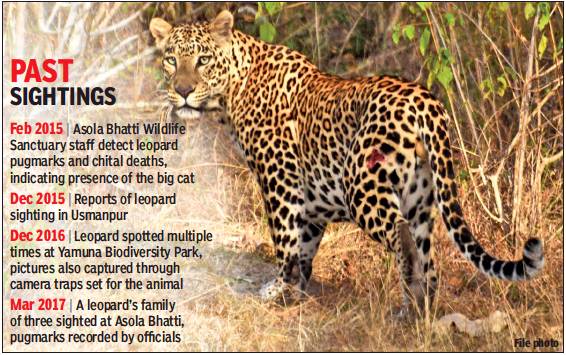
From: Jasjeev Gandhiok, Leopard sighting has Narela abuzz, April 11, 2018: The Times of India
Movement Near Air Force Station Recorded On Cam; No Pugmarks Found Yet
Narela had an unexpected guest on Monday evening. A leopard was spotted near the Air Force station—the second time in the capital after a leopard family of three was spotted at Asola Bhatti wildlife sanctuary last year.
Forest officials said the current sighting was even recorded on camera by people at the station, who then called up NGO Wildlife SOS. A special team was sent on Tuesday morning to the area even as the forest department also sent a team there. The latter were setting up a cage to capture the big cat.
“The sighting was confirmed by us before we sent a team. A team of Wildlife SOS will also patrol the area for the next few days to check if any pug marks can be found. Locals are also being alerted about the sighting,” said a senior forest official, adding that they would soon set up a cage in the area.
The forest department said it has also written to the Air Force station to send a copy of the video clip.
Officials said no pug marks have been found yet. “It is a large area and we will continue patrolling for the next few days. We are trying to look for pug marks that could indicate where the animal may be residing,” said the official.
But experts said it’s hard to determine how long the leopard may have been there, with sufficient food and water available. “The station area is quite secure and secluded, which is ideal for the animal, and it also has the Ghoga forest nearby. Leopards are very adaptable and generalist species, meaning they can fend for themselves easily and don’t need a specific prey base to survive. The area needs regular monitoring and setting up of mud traps to capture pug marks,” said Faiyaz Khudsar, scientist incharge at Yamuna Biodiversity Park, adding that the animal may have come to Delhi along the Yamuna corridor.
The park officials had spotted a leopard in December 2016, which was eventually caged and sent to the Shivaliks.
2019: Tilpath Valley park
Jasjeev Gandhiok, Leopard brings cheer to biodiversity park, February 16, 2019: The Times of India
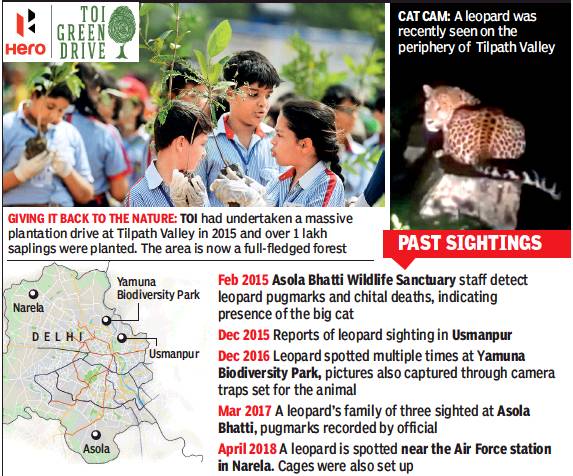
From: Jasjeev Gandhiok, Leopard brings cheer to biodiversity park, February 16, 2019: The Times of India
It’s A Sign Of Reforestation Working: Experts
Locals in the vicinity of Delhi Development Authority’s Tilpath Valley biodiversity park sighted a leopard and informed the park officials of the big cat’s presence recently. This can only be a good augury for the newly created biodiversity parks in the capital. A video shot by the residents of the nearby IGNOU colony has been submitted to the park staff, and spot checks for pugmarks are being carried out.
“While we have not seen any pugmarks yet, we were informed of the sighting last week,” said Dr R Jayakumar, scientist-in-charge at Tilpath Valley. “A video was also provided to us and locals from IGNOU reported a similar sighting earlier too. Our staff has been scanning the area for pugmarks. Once we can confirm the sighting, we will be able to report it.”
Tilpath Valley is DDA’s latest biodiversity parks and has seen tremendous habitat growth in the last few years, according to professor C R Babu, professor emeritus, Delhi University, and head of the Centre for Environmental Management of Degraded Ecosystems. Plans are in place to introduce herbivores, once the saplings planted there reach a decent height.
“The sighting of a leopard, which is a top predator, is an extremely positive sign for the reforestation at Tilpath Valley,” confirmed Babu. “Saplings planted 2-3 years ago have already grown to a height of 5-6 feet, some even as tall as 12 feet. Once they grow into trees, herbivores can be introduced to allow a proper food-chain cycle.”
TOI had undertaken a massive plantation drive at Tilpath Valley as part of the Hero TOI Green Drive in 2015, planting over one lakh saplings. Over 40,000 volunteers had taken part in the drive.
Dr Faiyaz Khudsar, scientist in-charge at the Yamuna Biodiversity Park, which too had a leopard sighting in 2016, revealed that pressure impression pads had been prepared and will be used to track the leopard’s movements. “Tilpath Valley is close to Asola Bhatti wildlife sanctuary, and the quality forest and secure surroundings here have provided an extended habitat for wildlife, especially carnivores,” Khudsar said. “There is an abundance of Indian hare and nilgai, which the leopard can prey on. The leopard is a highly adaptive species and a generalist feeder, meaning it can feed on a number of species.”
The last leopard sighting in the capital was in 2018 when a big cat was spotted near the Indian Air Force station in Narela. A leopard family of three was also sighted at Asola Bhatti in 2017, confirmed by pugmark recordings.
Tilpath Valley is DDA’s latest biodiversity park and has seen tremendous habitat growth in the last few years, according to DU professor C R Babu
Man-animal conflict
The Times of India, May 28, 2016
Jasjeev Gandhiok While dramatic sightings like a leopard in a PVR Saket mall in 2003 and a python slithering through another mall are not very common in Delhi, the nilgai that kept foresters and cops on their toes for nearly five hours at Vijay Chowk on Thursday shows that animals are straying from their habitat in search of food.
Forest officials say the Ridge, wetlands and other forest patches in NCR are drying up.“There isn't enough water or food for animals,“ said A K Shukla, chief wildlife warden. Officials pointed out that the walling of the Central Ridge and the segregation of other wild patches have severely restricted the movement of animals.
While wildlife islands were steadily created in the National Capital Region over the years, no effort was made to connect important corridors such as Mangar Bani in Haryana with the Asola Bhatti sanctuary or the Rajasthan Aravalis with the Haryana Aravalis. In other stretches, like the Yamuna banks, residential colonies came up. The result is a dwindling wildlife. Jungle cats haven't been seen in a long time, and while the forest department spotted pugmarks of striped hyenas recently , there were no direct sightings. Animal NGOs have reported a few leopard sightings and pugmarks in Asola Bhatti and around the Faridabad Aravalis. There may be very few blackbucks, porcupines, mongoose, nilgais and civet cats still extant.
There was talk of linking Mangar Bani with Asola by including these areas in the Haryana's eco-sensitive zone, but it remained just talk. There were also suggestions of making over-passes or under-passes for animals on the Gurgaon-Faridabad highway but nothing materialised.
“The Ridge is not a contiguous stretch, but a series of disjointed forests,“ explained Kartick Satyanarayan, co-founder of Wildlife SOS. “This means the animals cannot stay clustered in one area, and when they try to move around, the chances of their coming face to face with humans are high.“ Fencing work in these locations also disorients animals, which like Thursday's nilgai, then find it difficult to find their way back to their habitats.
Satyanarayan is clear that there is a need to sensitise people to man-animal conflicts because invariably crowds collect at a scene where an animal is sighted, aggravating the situation. He recollected that the leopard at the Saket mall was tranquillised but still had to be shot by the cops because there was panic among the people.
Wildlife SOS sees a huge jump in cases of conflict for the past five to seven years--majority of complaints are of snakes, monitor lizards, civet cats and birds like kites and owls.
According to Faiyaz Khudsar, scientist in-charge at the Yamuna Biodiversity Park, animals are increasingly trying to adapt to the concrete around them and to the massive crunch in food and water. This could be dangerous. “If an animal does not find enough food in the Ridge areas, it will naturally go elsewhere,“ said Khudsar. “So, seeing leopards or other animals in the city is not quite so unnatural.“
What little there is of wildlife in Delhi needs to be preserved. For this, among other steps suggested by experts, the Ridge will have to be treated as a “sanctum sanctorum“.
Eight leopard deaths between 2008-2016
Jayashree Nandi, Leopard deaths: A sordid old Aravali tale, Nov 29 2016 : The Times of India
Leopard deaths are not new in the Gurgaon Faridabad Aravalis. There have been at least eight such incidents in this region since 2008, prior to the lynching of a leopard by residents of Haryana's Mandawar village.Seven of these took place after 2014, according to submissions made to National Green Tribunal (NGT) in a recent case on a separate issue.
This, along with several camera trap studies, have confirmed the presence of the big cat in the region. But the Union environment ministry has not yet finalised the definition of forests in the Aravalis, leaving its habitat largely unprotected.
Hearing a case pertaining to the Faridabad section of the Aravalis in April 2014, the tribunal had ordered Haryana forest department, Union environment ministry and the Forest Survey of India (FSI) to determine if these areas were forests, as defined in the SC judgment in the Godavarman case of 1996. Haryana hasn't declared the forest status of the Aravalis yet. The environment ministry issued draft guidelines for recognition of forests in 2014, but never finalised those.
“We had installed camera traps here last year and found enough evidence of leopard presence. The definition of forest needs to be finalised to provide protection to the area from large commercial ventures. Recognition of the leopard presence will also mean that the forest department will get adequate infrastructure like tranquiliser guns,“ a forest official said. There is currently one tranquiliser gun for south Haryana.
Koustubh Sharma, senior regional ecologist with Snow Leopard Trust, who conducted camera-trap experiments to document wildlife around Mangar Bani (a sacred grove), said, “What happened before and after the moment of capturing the leopard on camera is even more fascinating. We saw that the leopard ran out as soon as a herder came with hundreds of goats. This shows their behavioural response to humans. They always avoid humans or dense habitations unless cornered.They don't get into any conflict otherwise,“ he said.
He added that in Sanjay Gandhi National Park in Mumbai where the community has been involved in wildlife conservation and prevention of man-animal conflicts.
Meanwhile, a case pertaining to four leopard deaths in a luxury golf course in Manesar is pending in a Faridabad court.
Humans encroachment causing conflict situation
Conflict corridor in the making, Nov 29 2016 : The Times of India
The appearance of a leopard in the Yamuna Biodiversity Park is rewarding news for the many who strove to restore the area into a natural ecosystem. And yet the big cat's presence is troubling because it recalls the killing of another leopard in urban surroundings at Mandawar not far from Gurgaon. Is the Yamuna park's newest inhabitant already at risk of violence from the people it might encounter?
Experts say that there are many areas in Delhi and around NCR where animals live.With humans encroaching into their habitat, they have been forced into the open and often in a conflict situation. Kartick Satyanarayan, co-founder of NGO Wildlife SOS, says that whenever a wild animal makes its way into a human habitation, people need to leave the animal alone and clear the area instead of taking matters into their own hands, as happened at Mandawar on Thursday . “Crowding the animal may actually aggravate the situation, forcing it to retaliate,“ says Satyanarayan.
The leopard, like many other animals, might have approached human space in search of food, explains Faiyaz Khudsar, scientist in charge at the Yamuna park. Saying that animals rarely harm humans first, Khudsar advises wildlife spotters to try and clear the area of people and call animal rescue officials as soon as possible. “Animals like leopards or nilgais will try to avoid humans and are not likely to attack them, but ignorance could lead to people making the situation worse,“ says Khudsar. An awareness drive is being conducted in areas near the Yamuna park to reassure people that the leopard is not a threat. Security measures have also been enhanced and monitoring increased at the park to ensure the leopard stays within the bounds.Khudsar emphasises that it is important people learn about the animals present in the Yamuna floodplain and in Delhi forests.
Creatures like snakes, civet cats, even nilgais, and on occasion leopards, wandering into human space is not rare in Delhi. Satyanarayan recollects a leopard spotting at a Saket mall in 2003. It had to be shot by the police due to apprehensions it might endanger the crowd milling around.Another case was reported in Faridabad in 2015, where despite Wildlife SOS's efforts, the villagers killed the cat.“We tranquillised the animal, but people overpowered us and attacked the sedated leopard,“ says Satyanarayan.
Sightings of leopards have gone up in the capital in the past few years, with camera traps in the Mangar and Bandhwari areas capturing a hyena and several leopards passing by . Leopard pugmarks were also noted at the Asola Wildlife Sanctuary .With a leopard now in the Yamuna Biodiversity Park, experts believe there is a greater need to sensitise people living in areas near forests that are rich in wildlife to animal appearances.
Snakes
See also: Snakes: India
Vipers
Viper wanders into colony, rescued Dec 20 2016 : The Times of India
A viper snake was rescued after it had wandered into a residential colony in Rohini.Identified as Russell's viper, the snake was discovered by a group of children who alerted animal rescue NGO Wildlife SOS for help.
A team of two trained rescue officials were sent to the spot, and after identifying the snake, cleared the area immediately.
“The team handled the reptile with caution as the fangs of a Russell's viper are the largest among Indian snakes and they react violently on being picked up. Therefo re, extreme caution had to be taken to carry out the rescue,“ said a rescue official.
The snake species is one among the four venomous snakes found in the Indian subcontinent and protected under schedule II of the Wildlife Protection Act, 1972.
Monsoons and snakes
Jasjeev Gandhiok, August 8, 2017: The Times of India
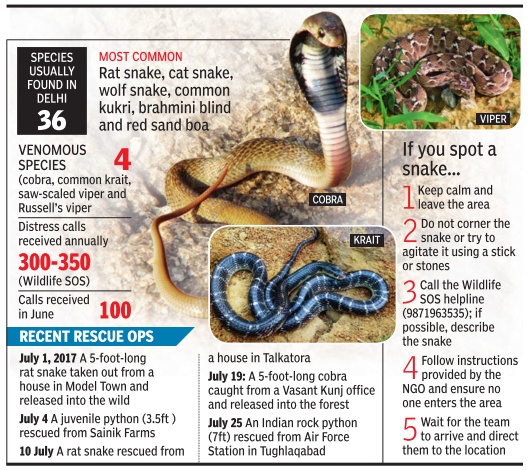
With monsoon hitting the capital this month, the chances of coming across a snake in your locality have also increased manifold, say wildlife experts. The snakes generally tend to come out due to excessive water filling up their burrows, while some species come out perilously close to human habitats, often in search of food.
In June alone, Delhi-based NGO Wildlife SOS received over 100 distress calls pertaining to snakes in the capital, while they receive about 300350 such calls annually . One rescue involved a seven-footlong Indian rock python from the Air Force station in Tughlakabad, with the snake spotted outside the mess building by Air Force officials.
The NGO says that sightings almost triple during this period, with snakes found either coiled up under rocks, hiding in drains and often in tall grasses where they end up in search of food.
“We are glad that people have become so aware that they consider calling experts instead of trying to deal with the matter themselves, or worse, resorting to killing the snakes. Our team has professionals who are trained to handle such situations efficiently. The rain brings these snakes out and with vermin like rats and mice available near human settlements, they often end up in urban spaces in hunt of food,“ said Kartick Satyanarayan, co-founder of Wildlife SOS.
Delhi has nearly 36 species of different snakes, however, only four venomous snakes are found in the capital -spectacle cobra, common krait, saw scaled viper and russell's viper. The NGO says snakes often try to find dry areas during this season and there have been instances where they have been found in ATM machines too. On July 10, a rat snake was rescued from a house at Talkatora, while the NGO rescued a five-foot long cobra from an office in Vasant Kunj after it was spotted in the office mess by a staff member.
“They often go in search of food and shelter in this weather and therefore can venture inside buildings,“ said Satyanarayan.
Experts say the season also marks a breeding period for certain snake species, making them come closer to human habitats. “Reptiles are coldblooded and hence undergo hibernation. During the summer and especially in monsoons, they come out to hide or feed. A lot of species are also known to breed during this season,“ said Dr Surya Prakash, zoologist from Jawaharlal Nehru University .
See also
Delhi: Wildlife (Fauna)
Asola Bhatti Wildlife Sanctuary (Delhi/ Haryana)
